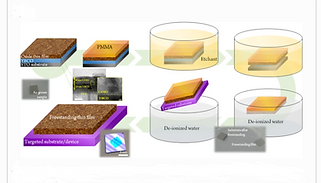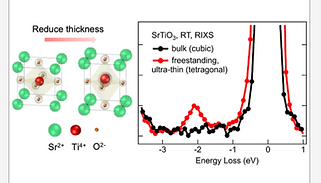top of page

JCY

Latest News

Research Interests
1. Complex oxide heterostructures, superlattices, and interfaces for next-generation applications.
2. Fabrication and characterization of oxide freestanding matters.
3. Optical control of strongly correlated phenomena.
4. Growth and characterization of quantum materials.
5. Functional oxide elements with controlled dimensionalities.
6. Multifunctional oxide electronics.
7. Twisted complex oxide bilayers and homostructures.
8. 2D/complex oxide heterostructures
Conventional complex oxide thin films available in our group
BiFeO3, LSMO, YBCO, SrRuO3, BaTiO3, PZT, LCMO, PCMO, SrTiO3, LaAlO3, SmFeO3, SrIrO3, LaFeO3, VO2, Al doped ZnO, LaNiO3, PbTiO3, CoFe2O4, NiFe2O4, NiCo2O4 and so on...
Development of new quantum materials
We employ state-of-art laser molecular beam epitaxy (laser-MBE) technique for thin film growth and a delicate combination of complementary tools (scanning probe microscopy, Raman scattering, PPMS, XRD, TEM, and various synchrotron-based techniques) for physical property identification, aiming to gain the comprehensive understanding for new quantum materials.

Deterministic optical control of room temperature multiferroicity in BiFeO3 thin films
Controlling ferroic orders (ferroelectricity, ferromagnetism and ferroelasticity) by optical methods is a significant challenge due to the large mismatch in energy scales between the order parameter coupling strengths and the incident photons. In this project, we demonstrate an approach to manipulate multiple ferroic orders in an epitaxial mixed-phase BiFeO3 thin film at ambient temperature via laser illumination.
Nature Mater. 18, 580 (2019).

A Fast Route Towards Freestanding Single-Crystalline Oxide Thin Films by Using YBa2Cu3O7-x as a Sacrificial Layer
Freestanding processes have been proposed, in which wet etching of inserted sacrificial layers is regarded as one of the most efficient ways to obtain epitaxial high-quality thin films. In this study, we propose using an alternative oxide, YBa2Cu3O7 (YCBO), as a sacrificial layer, which can be easily dissolved in light hydrochloric acid in a more efficient way, while protecting selected complex oxides intact. This approach enables direct integration of complex oxides with arbitrary substrates and devices and is expected to offer a faster route towards the development of low-dimensional quantum materials.
Nanoscale Res. Lett. 15, 172 (2020)

Extremely Fast Optical and Nonvolatile Control of Mixed-Phase Multiferroic BiFeO3 via Instantaneous Strain Perturbation
The phase transition and the correlated ferroic orders in multiferroic BiFeO3 (BFO) can be modulated via illumination of single short/ultrashort light pulses. Heat transport simulations and ultrafast optical pump-probe spectroscopy reveal that the transient strain induced by light pulses plays a key role in determining the persistent final states. Having identified the diffusionless phase transformation features via scanning transmission electron microscopy, sequential laser pulse illumination is further demonstrated to perform large-area phase and domain manipulation in a deterministic way. The work contributes to all-optical and rapid nonvolatile control of multiferroicity, offering different routes while designing novel optoelectronics.
Adv. Mater. 33, 2007264 (2021) (selected issue cover)

Presence of Delocalized Ti 3d Electrons in Ultrathin Single-Crystal SrTiO3
We show that thickness around 10nm, the freestanding STO films without the influence of a substrate show the tetragonal structure at room temperature, contrasting with the cubic structure seen in bulk form. The spectroscopic measurements reveal the modified Ti–O orbital hybridization that causes the Ti ion to deviate from its nominal 4+ valency (3d0 configuration) with excess delocalized 3d electrons. Additionally, the Ti ion in TiO6 octahedron exhibits an off-center displacement. The inherent symmetry lowering in ultrathin freestanding films offers an alternative way to achieve tunable electronic structures that are of paramount importance for future technological applications.
Nano Lett. 22, 1580 (2022)

Twisted oxide lateral homostructures with conjunction tunability
We reveal the growth of twisted oxide lateral homostructure with controllable in-plane conjunctions. The twisted lateral homostructures with atomically sharp interfaces can be composed of epitaxial “blocks” with different crystalline orientations, ferroic orders and phases. We further demonstrate that this approach is universal for fabricating various complex systems, in which the unconventional physical properties can be artificially manipulated. Our results establish an efficient pathway towards twisted lateral homostructures, adding additional degrees of freedom to design epitaxial films.
Nature Commun. 13, 2565 (2022)

Weaving correlated magnetic and electrical phenomena in lateral homostructures
Using La0.7Sr0.3MnO3, a classic strongly correlated material, the precise manipulation of epitaxial strain alongside the homojunction is demonstrated. This leads to a precisely controllable lateral homostructure composed of polymorphic ferromagnetic and antiferromagnetic LSMO regions. It is further identified that the interactions between the ferromagnetic and antiferromagnetic regions of La0.7Sr0.3MnO3 lead to unconventional ultrafast spin dynamics and magnetotransport behavior.
Small. 2411424 (2025)

Integration of freestanding hafnium zirconium oxide membranes into two-dimensional transistors as a high-κ ferroelectric dielectric
Here we show that freestanding hafnium zirconium oxide (Hf0.5Zr0.5O2; HZO) membranes can be integrated with two-dimensional semiconductors as a high-κ dielectric. The HZO membranes can be varied in thickness from 5 to 40 nm, and be transferred onto molybdenum disulfide (MoS2) to create the top-gate dielectric in field-effect transistors. A 20-nm-thick HZO membrane exhibits a dielectric constant of 20.6 ± 0.5 and a leakage current (at 1 MV cm−1) of under 2.6 × 10−6 A cm−2, below the requirements of the International Technology Roadmap for Semiconductors, as well as typical ferroelectric behaviour. We use the transistors to create an inverter, logic gates and a 1-bit full adder circuit.
Nature Electron. 8, 560–570 (2025)

bottom of page